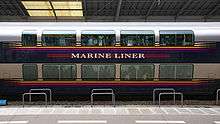Marine Liner
|
The Marine Liner 37 service to Takamatsu passing Sanuki-Fuchu Station, led by a JR Shikoku 5000 series EMU | |
| Overview | |
|---|---|
| Service type | Rapid |
| First service | April 1988 |
| Current operator(s) | JR West, JR Shikoku |
| Route | |
| Line used | Seto-Ohashi Line |
| Technical | |
| Rolling stock | 223-5000 series/5000 series EMUs |
| Operating speed | 130 km/h (80 mph) |
The Marine Liner (マリンライナー Marin Rainā) is the name of a train service in Japan operated by West Japan Railway Company (JR West) and Shikoku Railway Company (JR Shikoku) since April 1988. The Marine Liner links Okayama, the capital city of Okayama Prefecture and a major station on the Sanyō Shinkansen, with Takamatsu, the capital city of Kagawa Prefecture on the island of Shikoku, via the Great Seto Bridge. Operating at a top speed of 130 km/h (80 mph), the journey takes approximately 55–60 minutes.
Overview
Since 1 October 2003, the Marine Liner has been operated by JR West 223-5000 series EMU trainsets. The first car on most Takamatsu-bound trains is a JR Shikoku 5000 series bi-level cab car with reserved seating. Previously, 213 series EMUs were used.
From Okayama to Takamatsu, all Marine Liner trains stop at Chayamachi, Kojima and Sakaide. Most trains also stop at either Senoo or Hayashima, or both. Some early morning and late evening trains make additional stops at intermittent stations on the Seto-Ohashi and Yosan lines.
As it is classified as a "Rapid" (快速 kaisoku) service, a standard fare is charged for using the Marine Liner. It currently takes about one hour to cover the entire journey. A passenger may upgrade to reserved seating for an additional fee.
A crew change for the train driver and conductor occurs at Kojima, the boundary station between the two operating railways.
Route

The Marine Liner runs over two sections known collectively as the Seto-Ohashi Line. The Okayama-Kojima section is operated by JR West1, and the Kojima-Takamatsu section is operated by JR Shikoku2.
1Portions run over the JR Uno Line
2Portions run over the JR Yosan Line
Stations
- Key (as of December 2006)
| ■ | All trains stop |
| ▲ | Most trains stop |
| ♦ | Few trains stop |
| —- | Pass/No trains stop |
| Station | Service | |
|---|---|---|
| Okayama | 岡山 | ■ |
| Ōmoto | 大元 | ♦ |
| Bizen-Nishiichi | 備前西市 | ♦ |
| Senoo | 妹尾 | ▲ |
| Bitchū-Mishima | 備中箕島 | —- |
| Hayashima | 早島 | ▲ |
| Kuguhara | 久々原 | —- |
| Chayamachi | 茶屋町 | ■ |
| Uematsu | 植松 | ♦ |
| Kimi | 木見 | ♦ |
| Kaminochō | 上の町 | ♦ |
| Kojima | 児島 | ■ |
| Great Seto Bridge | ||
| Sakaide | 坂出 | ■ |
| Yasoba | 八十場 | —- |
| Kamogawa | 鴨川 | ♦ |
| Sanuki-Fuchū | 讃岐府中 | —- |
| Kokubu | 国分 | ♦ |
| Hashioka | 端岡 | ♦ |
| Kinashi | 鬼無 | ♦ |
| Kōzai | 香西 | —- |
| Takamatsu | 高松 | ■ |
Formations
Services are formed as 2-, 3-, 5-, or 7-car formations as shown below with car 1 at the Takamatsu end. All cars are no smoking.
- Green: Green class (first class)
- White: Standard class
- G (green class), R (standard class): Reserved seats
- NR (standard class only): Non-reserved seats
| 1 | 2 |
| 223-5000 series | |
| NR | NR |
| 1 | 2 | 3 |
| 5000 series | ||
| G | NR | NR |
| R | ||
| 1 | 2 | 3 | 4 | 5 |
| 5000 series | 223-5000 series | |||
| G | NR | NR | NR | NR |
| R | ||||
| 1 | 2 | 3 | 4 | 5 | 6 | 7 |
| 5000 series | 223-5000 series | 223-5000 series | ||||
| G | NR | NR | NR | NR | NR | NR |
| R | ||||||
History
The Marine Liner service was introduced in April 1988, using 3-car 213 series EMUs formed as three-car. six-car, or nine-car formations.[1]
References
- ↑ 列車名鑑1995 [Train Name Directory 1995]. Japan: Railway Journal. August 1995. p. 78.
External links
| Wikimedia Commons has media related to Marine Liner (train). |
- JR West Marine Liner information (Japanese)
- JR Shikoku Marine Liner information (Japanese)

.svg.png)